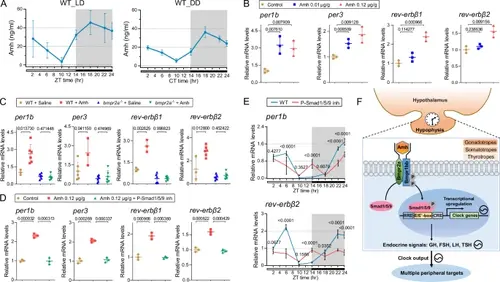Fig. 7
- ID
- ZDB-FIG-250602-39
- Publication
- Lin et al., 2025 - Anti-Müllerian hormone signalling sustains circadian homeostasis in zebrafish
- Other Figures
- All Figure Page
- Back to All Figure Page
|
Amh signal is transduced via Bmpr2a-Smad1/5/9 pathway to regulate the circadian rhythms.A The expression rhythm of Amh in WT zebrafish. B Quantitative real-time PCR analysis of core clock genes in pituitaries after treatment with different concentrations of recombinant Amh or saline as a control. The expression of control group was used for normalization. C Expression levels of clock genes in pituitaries after treatment with recombinant Amh in WT and bmpr2a−/− mutants. The expression of WT + saline group was used for normalization. D Expression levels of core clock genes in pituitaries after treatment with recombinant Amh, Amh + P-Smad1/5/9 inhibitor or saline as a control. The expression of control group was used for normalization. E The oscillation of clock gene expression in the WT pituitaries when P-Smad1/5/9 is inhibited. The expression of WT ZT2 was used for normalization. All the data are presented as mean values ± SD, and the individual data points are depicted (n = 3, part of n = 6 in (C)). Statistical analysis was performed using two-sided unpaired t-test. F A schematic model depicting the role of Amh/Bmpr2a-Smad1/5/9 signalling pathway in the regulation of circadian rhythms. We propose that Amh signalling regulates the oscillation of molecular clock in the hypophysis in a cell type-specific manner, thereby accurately gating the major output pathway of circadian information. Amh signalling deficiency causes corresponding circadian endocrine and behavioural rhythm disorders. Source data are provided as a Source Data file. |

